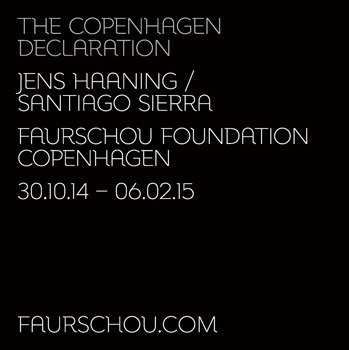Jens Haaning / Santiago Sierra
dal 29/10/2014 al 5/2/2015
Segnalato da
29/10/2014
Jens Haaning / Santiago Sierra
Faurschou Foundation, Copenhagen
The Copenhagen Declaration. A large installation that fills the whole of foundation's exhibition space. As with Haaning's and Sierra's other oevre, this is a work that takes its point of departure in socioeconomic and political matters.

Faurschou Foundation is pleased to present The Copenhagen Declaration by the artists Jens Haaning and Santiago Sierra. The show has been created specifically for Faurschou Foundation’s exhibition premises at the Copenhagen North Harbour. The two Danish curators Kim Kilde and Marie Thams initiated the collaboration between the two internationally recognized artists and Faurschou Foundation. The exhibition originates in the wish to link two powerful artistic practices that have both created striking, socially critical contemporary art. This is the first time the two artists have collaborated on a shared work as well as the first time Santiago Sierra exhibits in Denmark.
The Copenhagen Declaration is one large installation that fills the whole of Faurschou Foundation’s exhibition space. As with Haaning’s and Sierra’s other works, this is a work that takes its point of departure in socioeconomic and political matters. The work operates in the field between the ceremonial, formal declaration and the open statement of this declaration, which is dependent on context and the cultural background of the viewer. The artists have no wish for a direct communication or interpretation of this work, and there is no indication of who is the source or who is the recipient. Both Jens Haaning’s and Santiago Sierra’s works deal with issues of national origin, state boundaries and cultural differences, and their works urge reflection over the state of the world.
Jens Haaning (b. 1965) has from the outset of his artistic career been politically engaged. Back in the 1990s he was one of those who turned the focus on outsiders in Danish society. Many of his works take their starting point in marginalized groups, and through these he investigates intolerance and the condition of being alien or different. Haaning works with the meanings inherent in our language and the way we communicate visually, and he often makes use of a simple but precise device to deal with complex situations. His works range from the visibly political as in Weapon production (1995) to the more minimalistic, site-specific exchanging of light bulbs between a street in Kassel and one in Hanoi, Kassel-Hanoi (Light bulb exchange) (2002). Danmark, Denmark (2005) consists of the text “Denmark” written in large black capitals on the wall of the gallery. The first time the work was exhibited in Denmark in 2005, it aroused a sensation because the Danish political debate at the time was coloured by strong resistance to giving residence permits to immigrants and refugees in Denmark. Haaning’s work gets to grips with this debate, turning the focus, black on white, on concepts like nationalism and the fear of the foreign.
Santiago Sierra (b. 1966) is preoccupied in his practice with, among other issues, problematizing the value of labour, as can be seen in the many works where he pays excluded social groups to participate in what are often quite pointless, physically exhausting, directly humiliating, labour. This can be seen in the work 10 People Paid To Masturbate (2000) where ten men from Havana, Cuba, were paid 20$ to masturbate alone in front of a video camera. In 133 Persons Paid To Have Their Hair Dyed Blond (2001) 133 illegal immigrants from third-world counties in Asia and Africa were paid to have their hair bleached in connection with the Venice Biennale the same year. A small group of immigrants who primarily lived by selling copied bags were subsequently invited to sell bags as part of the actual art exhibittion. The work NO (2009) consists of a simple “No” in large black-painted letters. The expression only takes on meaning when it is placed in a context and the meaning changes depending on the specific setting of which it forms a part. Sierra in other words offers us a work that is on the one hand meaningless, but on the other hand can be inserted in a multitude of contexts and functions as a kind of protest or opposition to the way things work.
FAURSCHOU FOUNDATION
Faurschou Foundation is a privately owned art institution with a collection of contemporary art of the highest international class, with exhibition venues at Copenhagen North Harbour as well as Beijing’s attractive art neighbourhood 798. Faurschou Foundation introduces the visitors to some of the world’s most acclaimed artists. Art is purchased on an ongoing basis such that Faurschou Foundation’s collection is constantly developed and expanded.
Over a very short period since its establishment in 2011 Faurschou Foundation has profiled itself as a significant art institution that shows art at the highest international level with solo exhibitions of among other artists Cai Guo-Qiang, Louise Bourgeois, Ai Weiwei, Shirin Neshat, Gabriel Orozco and Danh Vo.
Press Contact:
Janna Lund +45 33 914131 janna@faurschou.com
Faurschou Foundation
Klubiensvej 11 2150 Nordhavn Copenhagen Denmark
Hours: Tuesday–Friday 11am–5pm



